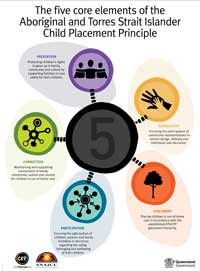Aboriginal and Torres Strait Islander Child Placement Principle
The Aboriginal and Torres Strait Islander Child Placement Principle recognises the importance of connections to family, community, culture and country. It guides our legislation, policy, and practice.
As we work with Aboriginal and Torres Strait Islander children, young people, families and communities, we use the Aboriginal and Torres Strait Islander Child Placement Principle to:
- understand and show in our work how culture is an important part of safety and wellbeing for Aboriginal and Torres Strait Islander children
- recognise and protect the rights of Aboriginal and Torres Strait Islander children, family members and communities to have a say in decisions that affect their lives.
When making a decision about an Aboriginal or Torres Strait Islander child, we consider the long-term effect of the decision on the child’s identity and connection with their family and community. The decision must also be made:
- in a way that allows the full participation of the child and the child’s family group
- in a place that is appropriate to Aboriginal tradition or Island custom
- in a way that upholds the following five elements of the Aboriginal and Torres Strait Islander Child Placement Principle:
- Prevention - that a child has the right to be brought up within the child’s own family and community.
- Participation - that a child and the child’s parents and family members have the right to participate in an administrative or judicial process for making a significant decision about a child.
- Partnership - that Aboriginal or Torres Strait islander peoples have the right to participate in significant decisions under the Child Protection Act 1999 about Aboriginal or Torres Strait Islander children, including the design and delivery of programs and services.
- Placement - that if a child is to be placed in care, the child has a right to be placed with a member of the child’s family group.
- Connection - that a child has a right to be supported to develop and maintain a connection with the child’s family, community, culture, traditions and language.
The Aboriginal and Torres Strait Islander Child Placement Principle also guides our department when making a decision about where an Aboriginal or Torres Strait Islander child or young person should live if they are placed in care.
When we are making a decision about the person in whose care an Aboriginal or Torres Strait Islander child we will arrange for the child to live with (in order of priority):
- a member of the child’s family group, including immediate family, extended family, clan, tribe or similar
- an Aboriginal or Torres Strait Islander person who is part of the child’s community or language group
- another Aboriginal or Torres Strait Islander person
- a person who lives near the child’s family, community or language group and is able to keep the child connected to kin, country and culture.
We also make sure the child and the child’s family have a say about who the child will live with, and that the child can keep relationships with family members and other people of significance to the child under Aboriginal tradition or Island custom.
- Last reviewed
- 22 May 2023
- Last modified
- 3 August 2023
 This work is licensed under a Creative Commons Attribution 4.0 International (CC BY 4.0) licence
This work is licensed under a Creative Commons Attribution 4.0 International (CC BY 4.0) licence


